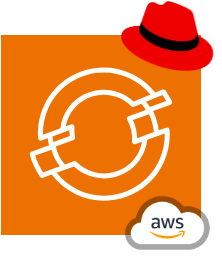Why Red Hat OpenShift on AWS - ROSA

For my daily research and development I primarily use the managed OpenShift service on AWS known as ROSA. It provides a ready-to-use Kubernetes cluster in under an hour pre-configured with network providers - CNI, storage providers - CSI, identity and access management (IAM), an administrator and a developer portal and much more.
A bunch of recent and existing additions make ROSA more compelling than ever and I want to share them here.
1. Hosted Control Planes
![]()
One of ROSA’s top value propositions is that it relieves users of the burden of installing, upgrading and managing cluster control planes.
Every Kubernetes cluster has three control plane nodes with hundreds of components that orchestrate cluster operations. The control plane is overhead most users prefer not to manage, and Red Hat OpenShift on AWS (ROSA) has always relieved administrators of this burden. Starting shortly, control plane node instances for ROSA clusters will be even further managed by Red Hat - the nodes won’t even show in the user’s account! Known as “Hosted Control Planes”, this update shifts the control plane entirely into Red Hat’s domain. With this change ROSA competes better with AWS’ own Elastic Kubernetes Service while still offering all of OpenShift’s additional benefits.
See this AWS doc for more on hosted control planes.
2. AWS Controllers for Kubernetes

With ROSA it’s natural to add AWS Controller for Kubernetes (ACK) and enable platform users to manage AWS-native resources in the same way as they manage other platform capabilities.
ACK has been available via OpenShift’s Operator Hub for some time. Its controllers make it easy to manage native AWS resources via the same control plane (aka orchestrator) alongside Kubernetes’ built-in and custom resource types. See this tutorial to get started. Crossplane is another popular way to achieve this, check out this old but still applicable post on Crossplane on OpenShift.
3. Virtual Machine Management
![]()
With Virtualization in ROSA you can specify and run VirtualMachineInstances in the exact same way as Pods.
A capability recently added to ROSA is the ability to run virtual machines (VMs) via KubeVirt on EC2 instances that include Kernel Virtual Machine (KVM). KubeVirt recently reached v1.0 and Red Hat OpenShift is one of few Kubernetes distros that already fully supports it. While it may seem like this capability is well-covered by EC2 in AWS, the benefit of Kubevirt is in using a common set of platform interfaces for both containers and VMs. For example, Kubevirt uses Container Network Interface (CNI), Container Storage Interface (CSI) and soon Container Device Interface (CDI) the same way as containers do.
4. Operator Hub
![]()
Operator Hub makes it easy to build an application or developer platform on Kubernetes.
In fact available in any OpenShift cluster, Operator Hub leverages Operator Lifecycle Manager to advertise and quickly install new Kubernetes extensions, capabilities and services in a cluster, such as OpenShift GitOps (ArgoCD), Service Mesh (Istio) and Pipelines (Tekton). Over 100 Red Hat-maintained operators can be installed as soon as the cluster is ready, as well as nearly 200 partner-certified offerings such as PostgresQL clusters and observability systems. With Operator Hub OpenShift becomes a platform for building your own platform - choose the capabilities you require, try implementations from Red Hat and partners, and finally choose and productionalize the best implementation and experience for your internal platform.
Relatedly, don’t miss my post on why Kubernetes should be the control plane of your application platform!
5. Developer Hub
![]()
Developer Hub makes it easy for platform users to observe and understand the products, components and capabilities they work with daily.
Also available for other OpenShift clusters, Developer Hub offers a single landing spot for developers to check on elements of the platform relevant to their daily work. Based on CNCF’s Backstage and its software catalog, Developer Hub provides an application- and component-centric view, bringing together in one pane of glass relevant source code repos, issue trackers, pipeline runners, observability dashboards and more.
A couple more
Another reason I appreciate ROSA is that it provides the same experience as I get with OpenShift in Azure Red Hat OpenShift (ARO) and on premises too. After a bit of unique provisioning for each infrastructure type, I interact in the same way with ROSA, ARO or bare metal clusters in my office closet!
Last but not least, I always appreciate that by using ROSA I’m automatically using the battle-hardened Red Hat Enterprise Linux kernel via Red Hat CoreOS to run all my systems - Kubernetes is containers is Linux after all.
Summary
Ready to try ROSA and experience these great features yourself? Here are a few resources to get you started.
- Quickstart from Red Hat: https://docs.openshift.com/rosa/rosa_hcp/rosa-hcp-sts-creating-a-cluster-quickly.html
- Quickstart from AWS: https://docs.aws.amazon.com/ROSA/latest/userguide/getting-started.html
- Tutorial: https://cloud.redhat.com/learn/getting-started-red-hat-openshift-service-aws-rosa
- Josh’s scripts and CLI walkthroughs: https://github.com/joshgav/platform/tree/main/clusters/openshift/aws/rosa
- Other ways to run OpenShift on AWS: https://blog.joshgav.com/posts/openshift-on-aws